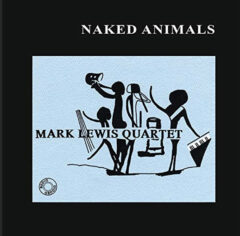

Recorded in 1990, but only released now, Naked Animals, by alto saxophonist Mark Lewis’ quartet, finds San Diego native James Long on bass.
Lewis, like Long, was an American ex-pat living in Amsterdam. Long was Lewis’ regular bassist for most of the 1980s, including for these sessions toward the end of the quartet’s run. Pianist Willem Kühne and drummer Frans von Grinsven round out the combo.
The eight tracks were all written by Lewis. Stylistically, it’s somewhere between bop and fusion—sounding more like the early ’70s than the early ’90s. Lewis plays in the upper register of his horn, often sounding like a soprano sax or even a recorder—giving the recording the patina of a vintage fusion set. (And when he switches to flute, it only enhances the feeling.)
And yet, the pace is often languid, and even on uptempo numbers like the title track, there’s an easy sense of relaxation that belies the fusion inflections. And on some numbers, like the closing “The Seven Angels,” there’s a kind of Eurojazz neo-classicism, a touch of the avant garde.
Not that the music ever spins completely into deconstruction – there’s always that solid foundation from Long and von Grinsven that keeps everything centered.
A longtime pianist in addition to bass (as a young man, he played piano locally with both Daniel Jackson and Leon Pettis), Long takes almost a piano-like approach to bass here. It’s not that he’s busy; it’s that he finds other possibilities to the bass that many bassists never even imagine. On a solo on the title track, his playing is quick and nimble, yet never showy. It’s technically brilliant, but wholly contained within his vision for the solo. It reminds of no one so much as the Swedish bassist Jonas Hellborg.
And on an extended solo early in “Dance With Monique,” Long’s deep, resonant picking pulls out tonal colors and variations one expects from a violin or viola, not a double-bass. His ability to shape notes in a way that augments what he is playing, that plays off the rest of the quartet, is an absolute joy to listen to. Repeatedly.
Kühne’s piano is stellar, providing a counterbalance to Lewis’ leads—comping behind him one moment, pushing him the next. And von Grisnven and Long are so in sync, it’s like watching a classic double-play tandem in baseball—it’s tough to pick up where one leaves off and the other begins. Think Davey Concepcion and Joe Morgan.
The compositions aren’t the strongest part of this release; there are few if any memorable hooks to get stuck in your head. But the songs are deep enough to offer the four players plenty of room to stretch out and express themselves, and that’s plenty to hold our attention.
It’s good to see that this recording is finally available, albeit 31 years after the fact.